Gdynia
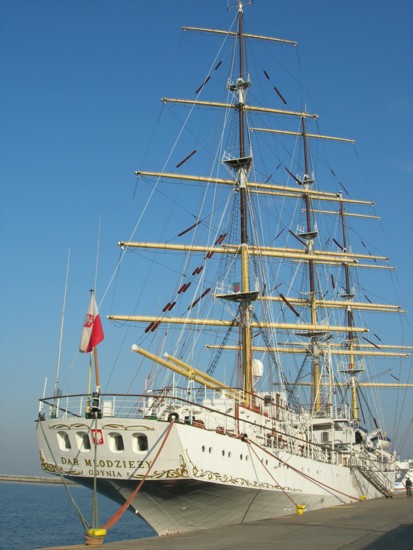
Training ship “Dar Młodzieży”, Gdynia. – Photo: Jakob Hoffmann
Distance
Population
249.257 (2008)
Location and history
Gdynia is located in northern Poland, on the Baltic Sea coast, ie. at Gdansk Bay. It is a young, attractive port city under rapid development, offering both commercial and tourist features as well as offers in higher education, culture as well as wider entertainment. Gdynia is a friendship town with Aalborg in Denmark. Gdynia is the northernmost of the cities of the so-called Trójmiasto (Trebyen), ie. the three closely related cities: Gdańsk, Sopot and Gdynia. The green area west of the three cities and east of the north-southbound highway / highway is laid out as a landscape park: Trójmiejski Park Krajobrazowy. Another green area is found along the bay, southeast of downtown. The central part of the city extends as a relatively narrow area along the bay. Only to the south and – especially – to the north, the suburbs extend further inland.
The port is one of the most important on the Baltic Sea coast of Poland with container terminal and fishing, naval and traffic ports. The very extensive port area is partly east, but especially north and northwest of the city center. From the Gulf of Gdańsk, there are three port inlets to the port area of Gdynia: a northern, a southern and the central inlet, from which one can continue further west into the inner harbor. The outer harbor, ie. the area directly facing the bay includes four large jetties; from south to north it is: the South Mill, the Fishing Mill, the Coal Mill and the Passenger Mill. The inner harbor comprises three moles, of which the easternmost is very wide. All the quays, ie. at the long sides of the pier and at the end of the pier each has their own names. The port basins between the piers, on the other hand, have numbers; there are 7 pools in total. At the inner harbor, west of the harbor basins lies the yard area. The shipyard, which dates back to 1922, went into liquidation in 2008.
The very special location of the city means that in Gdynia you can find fantastic viewpoints, coastal walks, construction sites, marinas and yacht clubs. Gdynia is the only city in Poland and one of the few in Europe to have such a long and easily accessible coastline, namely 12.5 kilometers – to which is added the harbor terrain. Gdynia has good traffic connections to the other cities of Trójmiasto, both in terms of trains from the local railway company SKM for Trojmiasto and the surrounding area as well as in terms of car traffic.
The city's airport is called Port Lotniczy Gdańsk im. Lecha Wałęsy (named after the trade union activist who fought the communist system in Poland, founder of the trade union “solidarity” and later the President of Poland). The airport is located near the village of Rębiechowo at ul.Słowackiego 200, ie. west of Gdańsk (and west of the highway). Gdynia is 23 km from the airport. There is a direct bus service to the center of Gdynia.
From Gdynia there is also a ferry connection to Karlskrona in Sweden.
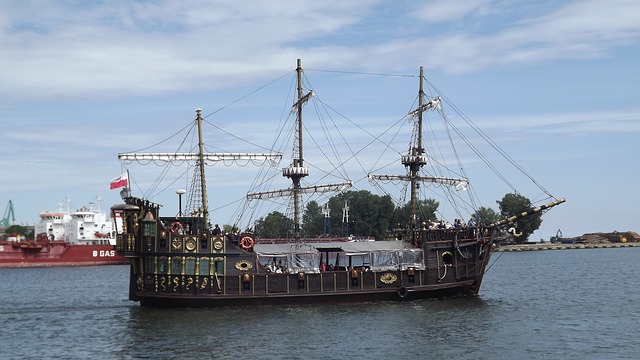
passenger boat “Regina”, sailing with tourists in the port of Gdynia and in the Gulf of Gdańsk. – Picture of danuta niemiec from Pixabay
Poland regained its independence as a state in 1918, but did not immediately gain access to the sea that it needed. Poland was granted such access only in July 1920 as a result of the Treaty of Versailles, as a land strip, which ended in the north end of the Baltic Sea, in the Gdynia area, was granted Poland. This strip of land, called the Polish Corridor, thus separated the then Germany from likewise German East Prussia. At the same time, Gdańsk was declared a sanctuary, but in a customs union with Poland. Initially, there was no port on the Baltic Sea coast of the Polish Corridor, and such was a great desire, also because the Poles would avoid problems with the use of the port in the Gdańsk sanctuary. As early as 1920, a proposal was made to build a Polish naval and traffic port on the grounds that precisely Gdynia would be the right place to build such a port. On September 23, the Polish parliament, Sejm, decided to build a port at Gdynia. Construction began in 1921 and the port was inaugurated in 1926. However, expansions occurred throughout the interwar period. The construction on the site was quite limited at that time. You can see on a map from 1924 how only two or three streets in the later city center were more densely built at that time. In 1925, a committee was set up to guide urban development. From 1926 – where the city was granted market town rights – the development of the city took off and it continued for the rest of the interwar period. A dramatic slowdown occurred when World War II broke out. At that time (in 1939) the number of inhabitants had grown to 120,000. The city as such was not significantly destroyed by bombings such as e.g. Warsaw or Gdańsk, but the port and yard were totally destroyed. The majority of the Polish inhabitants were displaced by the Germans or placed in concentration camps. After the war, the port was rebuilt and expanded, just as the yard was rebuilt. When Gdynia was liberated in 1945, the inhabitants began to return to the city; Residents of ruined cities in Poland, not least from Warsaw, also sought out Gdynia to create a new home here. In December 1970, the shipyard workers in Gdynia as well as in Gdańsk took part in the uprising against the regime.
Tourist attractions
Selected attractions:
The main attraction for tourists is the sailboats moored by quays and other construction sites, including historic vessels.
Tourists looking for entertainment, especially in the evening, should visit the largest entertainment center in town, namely “Gemini”. During the summer season you can use the tourist boat “Viking II”, which during the daytime sails several trips in the Gdansk Bay, while in the evening it serves as a floating restaurant.
Unforgettable views from the depths of the gardens will be given to visitors to the Oceanographic Museum and the Aquarium.
Recommended for a long stroll along the wide promenade: Bulwar Nadmorski. The promenade was actually built to fortify the coastline, but it quickly became a favorite destination for strolls, both for residents and tourists. Bulwar Nadmorski is 1.5 km long and also has a bike path.
You can admire the beautiful view of the harbor and town from Kamienna Góra, the smallest district in Gdynia, but at the same time the name of a moraine hill whose peak reaches 52 meters above sea level. The district lies between the seafront and ul.Świętojańska. In the Kamienna Góra district you will find Navy Museum (Marynarki Wojennej Museum).
Walking from the city center towards Kamienna Gora, you pass Plac Grundwaldzki with the famous Music Theater (Teatr Muzyczny), known for its excellent musical repertoire.
Another famous cultural institution in Gdynia is Teatr Miejski (ie the City Theater). This theater has a summer scene on the beach in the Orłowo district (southern Gdynia). Also in the main theater of the Stadsteater “Sax Club”, where there are evening jazz concerts with artists from all over the world.
Gdynia is also a good choice if you love to go shopping. Most attractive here is the city center with luxury shops on the streets of iwiętojańska and Starowiejska. Where the streets 10 Lutego and Władysława IV intersect are the modern department store “Batory“In addition to the successful shopping, you can enjoy the exciting architecture. Large shopping malls are located on the outskirts of the city.
Kościuszko Square (Skwer Kościuszki)
The city's tourist center is the square of Skwer Kościuszki at the intersection of Świętojańska and 10 Lutego streets. It is the most representative space in the city. In this place stands a statue in memory of Pope John Paul II’s (Jan Paweł II) visit. A characteristic element is the fountain. The venue is a popular meeting place not only for tourists but also the city's own inhabitants, as well as it is home to concerts, festival events and other events. The site is located just west of the South Mill (Molo Południowe), which can be considered an extension of the square.
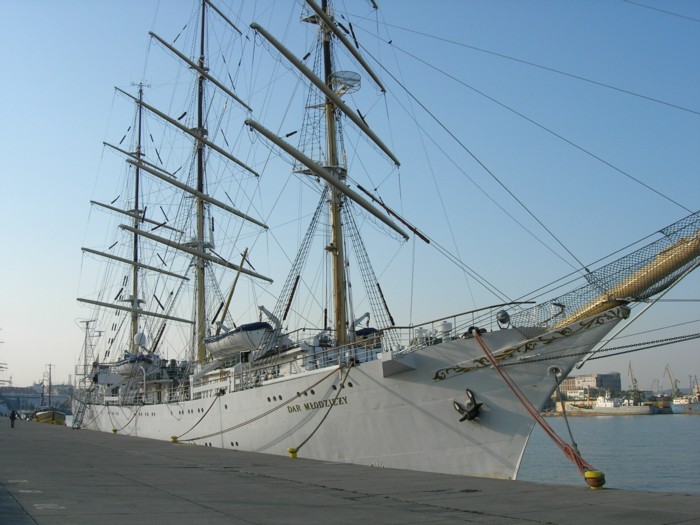
“Dar Młodzieży”. – Photo: Jakob Hoffmann
South Mill (Molo Południowe)
This pier, which is an eastern extension of Skwer Kościuszki Square, is actually an artificial peninsula created in the 1920s. It soon gained the status of being the most picturesque place in the newly built city. Here is the Gdynia Aquarium, the Naval Academy's Navigation Department, the shipping company “Luegluga Gdańska”‘s passenger terminal, a yacht club, etc. Not least here at the South Mill is the Polish destroyer ORP Błyskawica (“The lightning”) as well as the most famous Polish sailing ship: Dar Pomorza (“The Gift of Pomerania”) is moored on the north side, by the Pomeranian Quay (Nabrzeże Pomorskie). These museum ships are very much worth a visit.
Błyskawica – Museum ship (Błyskawica – Okręt-Muzeum)
This vessel, now serving as a museum, is located at the South Mill (Molo Południowe). The street is called Al.Zjednoczenia.
“Błyskawica” is one of the most beautiful ships in its class. This Polish destroyer was built in 1935-36 in England (displacement: 2145/3380 tons, length 114 m, draft 3.3 m, speed: 39 knots (72 km / h), armor: 8 102 mm guns). In 1937 the destroyer sailed to Gdynia and until the start of the war it served under the Polish navy. On August 30, 1939, the ship was shipped to Great Britain (to avoid German destruction). Along with the twin ship “Grom” it was the fleet's pride. The ship's crew fought bravely in the North Sea, the Mediterranean, the Atlantic, the English Channel and the Bay of Biscay. During the war, the ship lowered 2 destroyers and 2 escort ships, damaged 3 submarines and shot down 3 enemy aircraft. “Błyskawica” also performed duties as an escort ship for allied troop transports, e.g. with “Queen Mary”. From 1976 it has served as a museum ship based in Gdynia. In that role, it replaced the twin ship “Burza”. Such museum ships are few in Europe, while there are several in the United States. European museum ships include Russian “Aurora”, the English “Belfast”, “Victory” and “Warrior”, 3 Swedish and 2 Danish (Frigates) “Jutland” and “Peder Skram”).
Dar Pomorza – Department of the Central Maritime Museum (Dar Pomorza – Oddział Centralnego Muzeum Morskiego)
The vessel that is called “The White Frigate”, lies (similar to “Błyskawica”) at the South Mill (Molo Południowe), at the Pomeranian Quay, ie. on the north side of the pier. The ship, inextricably linked to the city of Gdynia since 1930, was built in 1909 in Hamburg, initially as a school ship for the German war fleet. The ship was launched on September 18, 1909 and given the name “Princess Eitel Friedrich”. His maiden voyage made the ship in April 1910 when it sailed to Kristiansand and Antwerp. After Germany's defeat in World War I, France took over the ship in 1919, after which it sailed to the port of Saint Nazaire. In 1926 the ship was given a new name: “Colbert”, and it was intended to replace the French school sailing ship “Richelieu”, but this was not realized. In 1927 the ship was purchased by Baron de Foreste, who was planning to furnish the ship for an ocean yacht. In 1929, the National Pomeranian Naval Commission purchased the ship for a sum of 7,000 pounds sterling. The ship was to replace an old school ship, the bark “Lwów”. In December 1929 the ship sailed under the name “Pomerania” from Saint Nazaire to the shipyard in Nakskov, Denmark, to undergo a thorough renovation and reconstruction to some extent. Then the ship got a new name again, this time “Dar Pomorza”, commemorating the sacrifice of sacrifice on the part of the Pomeranian community. Anchored on June 19, 1930 “Dar Pomorza” for the first time on the nest at Gdynia. On July 13, a ceremony was held in which Bishop St. Okoniewski blessed the ship. “Dar Pomorza” was surrendered to the State Maritime School in Gdynia, where the ship was to function as the other one (after “Lwów”) primary school for navigators. On his first school trip under the Polish flag sailed “Dar Pomorza” out on July 20, 1930, under the command of Captain Konstanty Maciejewicz. On this voyage the ship sailed around the British Isles and all the way to Bergen in Norway; On September 30, they returned to Gdynia. For the following 51 years, while “Dar Pomorza” served as a vessel in the Polish merchant fleet, the ship made 102 school sailing trips, during which it traveled approx. half a million miles. 13,384 students at the maritime school were trained on board “Dar Pomorza”. During World War II – from September 1, 1939 to October 21, 1945 – the ship lay in Stockholm. It returned to Gdynia on October 24, 1945, after which it resumed its service as a school ship under the State Maritime School. “Dar Pomorza” have won “Operation Sail” 2 times. In addition, the ship won “Cutty Sark Trophy” in 1980. It was one of the first seats under regattas in 1974, 1976 and 1978. Its last sailing took the ship in September 1981 – to Kotka in Finland. In August 1982, “Dar Pomorza” taken out of active service. Its successor as a school ship became “Dar Młodzieży”, built in Gdynia.
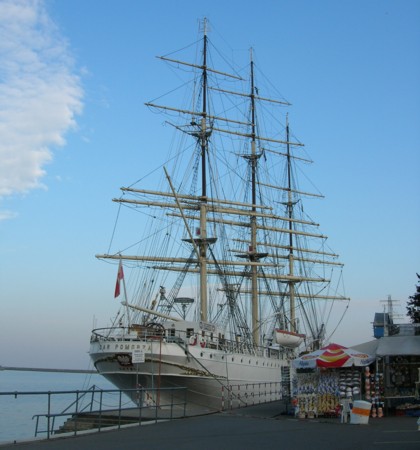
The museum ship, the former school ship “Dar Pomorza”. – Photo: Jakob Hoffmann
Oceanographic Museum and the Aquarium (Muzeum Oceanograficzne in Aquarium Morskie)
The Oceanographic Museum and the Aquarium in Gdynia originated in 1971 with the purpose of collecting and making available examples of flora and fauna in the seas. The exhibitions are divided into a museum section and an aquarium section.
The museum exhibits properly prepared samples of marine plants and marine animals, as well as numerous posters, models and other forms of making available the comprehensive and diverse knowledge of marine life and utilization of the sea. The museum section includes a number of exhibition halls, including the Didactic Hall, the Invertebrate Hall and the Baltic Hall.
In the Didactic Hall, however, Consider prepared examples of fish, reptiles, birds and mammals that live in or by the sea. Among the most interesting are: stork, hammerhead, iguana and albatross. In addition, there are wall exhibitions that show the research techniques used, as well as forms of utilization of marine resources. Much can also be learned about the distribution of fish and mammals as well as the anatomy and morphology of the animals. Visitors also draw attention to dioramas that represent the plant and wildlife in the Sargasso Sea, Antarctica, coral reefs and mangrove swamps.
The Hall of Invertebrates: This exhibition consists of 14 booths in which – in systematic order – specimens representing different groups of invertebrates are presented. One can thus see here, among other things. fungi, hedgehog cells, sea brushworms, molluscs, arthropods and echinoderms.
The Baltic Hall (Baltic Sea Hall): The most interesting element of this hall is the plastic map showing how the seabed in the Baltic Sea has been shaped. In addition, the exhibitions are: “The Baltic Sea yesterday and today”, “Let's save our Baltic”, “The flora and fauna of the Baltic Sea” as well “Birds and mammals in the Baltic Sea”.
In the aquarium you can see sea creatures from oceans and other salty waters around the world as well as freshwater animals from lakes and rivers from almost every continent. In 29 aquariums ranging from 500 to 16,000 liters are located approx. 1200 animals belonging to approx. 150 species. Here are fish, representatives of marine crawlers, including turtles as well as several invertebrates. The main attraction of the aquarium exhibition is a huge container of 2700 liters of water containing a living coral reef and can present approx. 40 species of coral animals as well as numerous specimens of mushrooms, seabrush worms, crustaceans, clams, snails, sea urchins and exceptionally colorful tropical fish. In an even larger aquarium of 16,000 liters, three species of sea turtles are displayed. Significant attention also attracts the freshwater aquariums, where you can see, among other things. the infamous piranha (piranha), beautiful neon fish, and lung fish that breathe in atmospheric air. There are also interesting fish from the Baltic: hero, eel squid, black-mouthed goblet, wolf and flatfish.
Anyone who wants to know the secrets of the deep sea should visit the Gdynia Aquarium. The aquarium's teaching department is very well functioning. All guests, especially children and young people, can acquire new knowledge during the lectures given by specialists in oceanography, biology and environmental protection.
Passenger ships' avenues
On July 1, 2001, the only Polish was opened in Gdynia “Passenger ships' avenues”, i.e. an avenue with blackboards in memory of all the passenger ships that have entered the port of Gdynia over time. The panels, mounted on the north side of the South Mill, are made of green Italian granite, which is carved a drawing of the ship, the name of the ship and other information.
The Science Center Experiment (Center Nauki Experiment)
This center is the first of its kind in Poland, where science and entertainment are linked, making it an attractive way to spend your time. A visit to the Experiment allows the visitor to acquire knowledge, to understand the processes that are going on, while aroused a natural curiosity about the outside world and the laws that prevail in nature. The experiment is an excellent tourist attraction for anyone visiting the Pomeranian region. It is an offer that is suitable for the whole family while being attractive to schools. – The experiment consists of 40 departments divided into 5 thematic groups: Man, the Environment, Sounds, Physics and Optics. Everywhere, the intention is to provide understanding and explanation of the phenomena that occur in the surrounding world. All installations are available; they must be tested to conduct the experiment.
Havneterminalen (Dworzec Morski)
The port building, built in 1933, is recognized as one of the most interesting building monuments in Gdynia. Until the outbreak of the war, the building was the base of the transatlantic fleet. In connection with an allied air attack on the port in 1943, the port building was severely damaged; it was rebuilt after the war, but not quite with the splendor of the building before the war. The harbor building still functions as such, and from here one can admire the beautiful passenger ships sailing under flags from all over the world. The building is located on the French Quay at the Passenger Mill.
Archangel Michael's Church (Kościół Św. Michała Archanioła)
The first written testimony of this, the oldest church in Gdynia, dates from 1224. The church is located near the coast in the northern district of Oksywie, where the Naval Academy (Akademia Marynarki Wojennej) is located. For many centuries it was first and foremost a church for sailors. In the cemetery belonging to the church rests many highly deserved people from the city and the area.
Gdynia City Museum (Miasta Miasta Gdyni)
The Gdynia City Museum dates from 2007 and is located in a new building near the beach. The main purpose of the museum is to prepare documentation and provide widely available information about Gdynia’s history, including in particular the importance of the city and the port in the new-born Poland after the First World War. The museum organizes exhibitions on historical subjects, just as it often hosts exhibitions from other collections, both Polish and foreign – not only in history, but also in art and culture in a broad sense. The city museum has over 56,000 exhibits in painting, graphics, sculpture, textiles, medals, maps and plans, photographs and postcards, clothing, furniture and material cultural objects. The museum's library holds over 9,000 volumes.
Planetarium
During a visit to the Planetarium, you can have the opportunity to observe about a thousand stars and other celestial bodies, view the planets, gain a better understanding of phenomena such as solar and lunar eclipses and get to know other interesting astronomical phenomena. The planetarium is open every day.
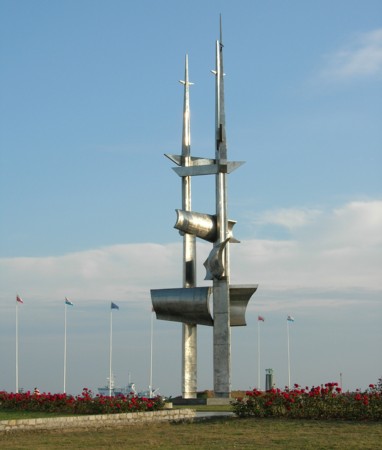
The sculpture “Żagle“ (“sail”) at Aleje Jana Pawła II (at the South Mill), Gdynia. The artwork is a composition based on the ship's master. – Photo: Jakob Hoffmann
Surrounding Area
Area attractions, see among others:
Gdańsk
Sopot
Kartuzy
Crusader castles and bishopric castles in northern Poland
Accommodation
Booking.com
Gdynia (Polish, English, German, Swedish, Russian) – with practical information for tourists.
Other Internet sites and sources
Gdynia (Polish, English, German, Swedish, Russian). From this page you can download a leaflet in English and Polish with practical information for tourists.
Trojmiasto: Gdańsk, Sopot, Gdynia
Other cities in Trojmiasto:
Gdańsk (Polish, English, French, German and Russian)
Sopot (Polish, English, German, French, Russian)
Gdynia. Plan miasta. Scale ok. 1:20 000. PPWK, 1987.
Trójmiasto. Plany miast.
Poland. Gdańsk, Sopot, Gdynia. Warsaw, POT, 2004.
Translated into English by Google Translate. Spangshus.dk accept no liability for any errors or omissions in translation.
Map

Rating
Search
Most used tags
churches (205) Castles (86) Monasteries (79) Town walls (74) Lakes (71) Town halls (67) Rivers (65) Castles1 (62) Mansions (55) Museums (51) Regional museums (38) Town gates (36) Abbey churches (35) Castle ruins (30) Cathedrals (26) Forests (25) Health resorts (24) Water sports (23) Mounds (23) National parks (22)Click for all tags
Denne side er også tilgængelig på dansk. This page and contents is (c) Copyright 2018- www.spangshus.dk. Based on Inviator software by ISCA Software